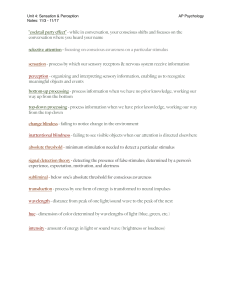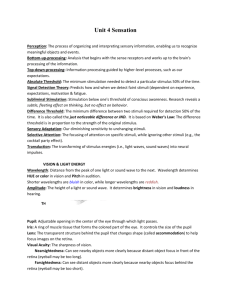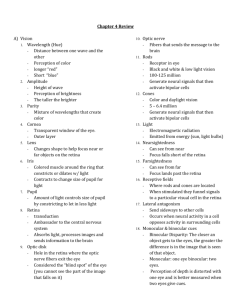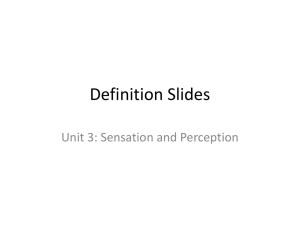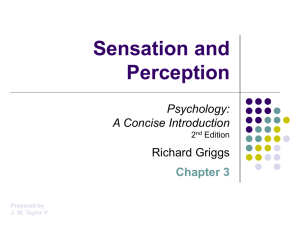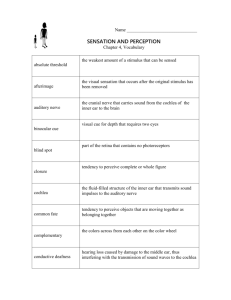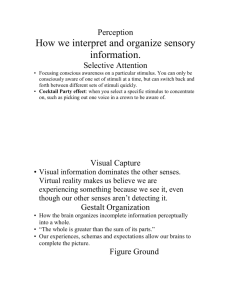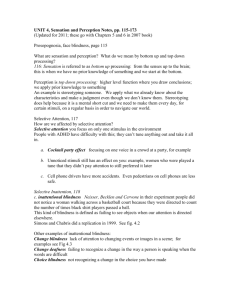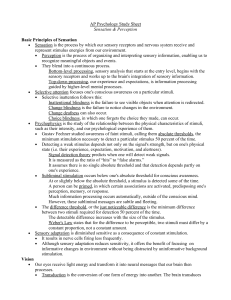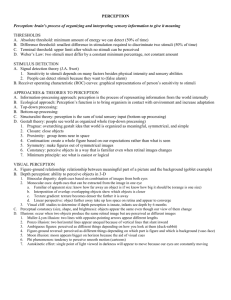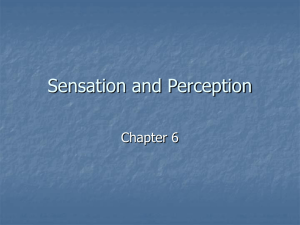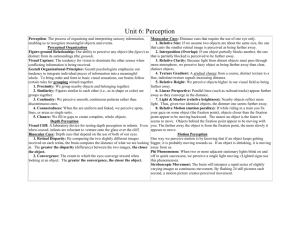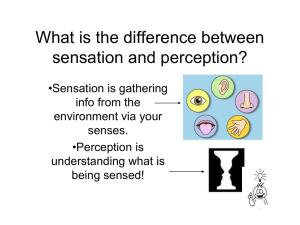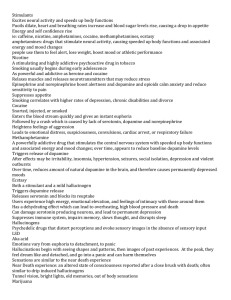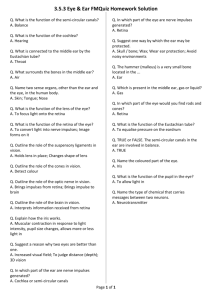Unit 4 Factsheet - Squalicum High School
advertisement
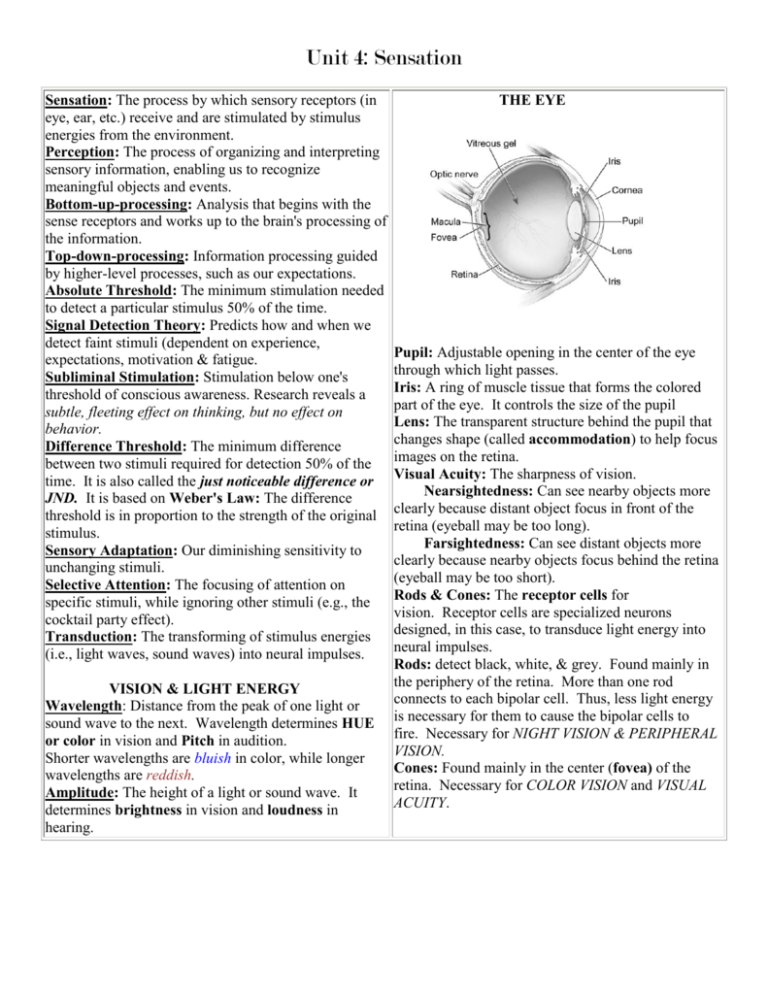
Unit 4: Sensation Sensation: The process by which sensory receptors (in eye, ear, etc.) receive and are stimulated by stimulus energies from the environment. Perception: The process of organizing and interpreting sensory information, enabling us to recognize meaningful objects and events. Bottom-up-processing: Analysis that begins with the sense receptors and works up to the brain's processing of the information. Top-down-processing: Information processing guided by higher-level processes, such as our expectations. Absolute Threshold: The minimum stimulation needed to detect a particular stimulus 50% of the time. Signal Detection Theory: Predicts how and when we detect faint stimuli (dependent on experience, expectations, motivation & fatigue. Subliminal Stimulation: Stimulation below one's threshold of conscious awareness. Research reveals a subtle, fleeting effect on thinking, but no effect on behavior. Difference Threshold: The minimum difference between two stimuli required for detection 50% of the time. It is also called the just noticeable difference or JND. It is based on Weber's Law: The difference threshold is in proportion to the strength of the original stimulus. Sensory Adaptation: Our diminishing sensitivity to unchanging stimuli. Selective Attention: The focusing of attention on specific stimuli, while ignoring other stimuli (e.g., the cocktail party effect). Transduction: The transforming of stimulus energies (i.e., light waves, sound waves) into neural impulses. VISION & LIGHT ENERGY Wavelength: Distance from the peak of one light or sound wave to the next. Wavelength determines HUE or color in vision and Pitch in audition. Shorter wavelengths are bluish in color, while longer wavelengths are reddish. Amplitude: The height of a light or sound wave. It determines brightness in vision and loudness in hearing. THE EYE Pupil: Adjustable opening in the center of the eye through which light passes. Iris: A ring of muscle tissue that forms the colored part of the eye. It controls the size of the pupil Lens: The transparent structure behind the pupil that changes shape (called accommodation) to help focus images on the retina. Visual Acuity: The sharpness of vision. Nearsightedness: Can see nearby objects more clearly because distant object focus in front of the retina (eyeball may be too long). Farsightedness: Can see distant objects more clearly because nearby objects focus behind the retina (eyeball may be too short). Rods & Cones: The receptor cells for vision. Receptor cells are specialized neurons designed, in this case, to transduce light energy into neural impulses. Rods: detect black, white, & grey. Found mainly in the periphery of the retina. More than one rod connects to each bipolar cell. Thus, less light energy is necessary for them to cause the bipolar cells to fire. Necessary for NIGHT VISION & PERIPHERAL VISION. Cones: Found mainly in the center (fovea) of the retina. Necessary for COLOR VISION and VISUAL ACUITY. Unit 4: Sensation (cont.) VISION (cont.) Light waves stimulate rods & cones which synapse to bipolar cells, which synapse to ganglion cells. The axons of the ganglion cells come together to form the Optic nerves which transmit visual information to the brain. Blindspot: The area in the retina where the optic nerve leaves the back of eye. No rods or cones are located there, so no vision is possible at that location. Feature Detectors: Nerve cells in the brain that respond to specific features of a visual stimulus, such as shape, angle, or movement. Parallel Processing: The ability of the brain to process several aspect of a situation simultaneously. COLOR VISION Young-Helmholtz Trichromatic Theory: The theory that the retina contains three different types of cones-one most sensitive to red, one to blue, and one to green--which when stimulated in combination can produce any color. RED, GREEN, & BLUE are the PRIMARY COLORS OF LIGHT WAVES. Opponent Process Theory: Theory that opposing retinal processes (red-green, yellow-blue, & blackwhite) enable color vision. For example some cells are stimulated by red while inhibited by green; others are stimulated by yellow, while inhibited by blue. This helps explain afterimages. Color constancy: Perceiving familiar objects as having consistent color, even if changing illumination alters the wavelength reflected by the object. Middle Ear: Chamber between the eardrum and the oval window which contains the ossicles (three tiny bones--hammer, anvil, & stirrup) which concentrate the vibrations of the eardrum. Inner Ear: Contains the cochlea, semicircular canals, and vestibular sacs. Cochlea: a coiled, bony, fluid-filled tube through which sound waves trigger nerve impulses. Basilar Membrane: Membrane along the center of the cochlea that contains hair cells (the receptor cells for sound). Axons from the hair cells for the Auditory Nerves, which transmit neural impulses to the brain. PITCH PERCEPTION Place Theory: Theory that the pitch we hear is associated with the place where the basilar membrane is stimulated. Best for explaining high-pitched tones. Frequency Theory: Theory that the rate of nerve impulses traveling up the auditory nerve matches the frequency of the tone we are hearing. Best for explaining low-pitched tones. AUDITION Volley Principle: Helps explain in frequency theory Audition: The sense of hearing. how we can hear sounds with a frequency greater than Frequency: The number of complete wavelengths in a 1000 cycles per second. While some neurons are given period of time. Frequency determines pitch. "recharging" during the refractory period, others are Amplitude: Height of each wavelength--determines firing. loudness. Conduction Deafness: Caused by damage to the structures that conduct sound waves through the ear Sound Localization: Sound waves strike one ear (eardrum, ossicles). sooner and with more intensity than the other Nerve Deafness: Caused by damage to the cochlea's ear. With this information, the brain can determine the hair cells or the auditory nerve. location of the sound. Unit 4: Sensation (cont.) TOUCH Touch or tactile sense involves a mixture of at least 4 distinct skin senses--pressure, warmth, cold, and pain. Only pressure has identifiable sense receptors. COLD + PRESSURE = WETNESS COLD + WARMTH = HOT PAIN Gate-Control-Theory: Theory that the spinal cord contains a neurological "gate" that blocks pain signals or allows them to pass. The gate is opened by stimulation of small nerve fibers and closed by stimulation of larger fiber or by information coming from the brain. TASTE Taste is the Gustatory Sense. Taste is a CHEMICAL SENSE and consists of the four basic tastes of sweet, sour, bitter, & salty. There may also be a 5th sense called "umami" or a meaty taste. Each bump on the tongue contains over 200 taste buds. Each bud contains a pore that captures food molecules. The molecules cause hair-like neurons within the pores to fire. Taste Buds reproduce themselves every 2-3 weeks. Sensory Interaction: The principle that one sense may be influenced by another, as when the smell of food influences its taste. SMELL Smell is the Olfactory Sense. Smell is also a CHEMICAL SENSE. Very little is known about the olfactory sense. However, we are able to detect about 10,000 different odors. Smells are processed in the temporal lobes of the brain and in the LIMBIC SYSTEM, which may explain why certain smells seem to have an emotional component and can trigger memories. Molecules in the air reach millions of receptor cells in each nasal cavity. These cells send messages to the olfactory bulb and the olfactory nerve which transmits the messages to the brain. BODY POSITION & MOVEMENT Kinesthesis: The system for sensing the position and movement of individual body parts. The receptor cells for kinesthesis are found in our muscles, tendons, & joints. Vestibular Sense: The system that monitors the head's (and thus the body's) position and movement. It is our sense of equilibrium. The semicircular canals and vestibular sacs in the inner ear contain receptors that tell us about our head's position. Unit 4: Perception Perception: The process of organizing and interpreting Monocular Cues: Distance cues that require the use of sensory information, enabling us to recognize one eye only. meaningful objects and events. 1. Relative Size: If we assume two objects are about the same size, the one that casts the smaller retinal image is perceived as being farther away. Perceptual Organization 2. Interposition (Overlap): If one object partially Figure-ground Relationship: Our ability to perceive any object (the figure) as distinct from its surroundings blocks another, the one that is partially blocked is perceived to be farther away. (the ground). 3. Relative Clarity: Because light from distant Visual Capture: The tendency for vision to dominate the other senses when conflicting information is being objects must pass through more atmosphere, we perceive hazy object as being farther away than clear, received. distinct objects. Gestalt Organizational Principles: Gestalt 4. Texture Gradient: A gradual change from a psychologists emphasize our tendency to integrate coarse, distinct texture to a fine, indistinct texture individual pieces of information into a meaningful signals increasing distance. whole. To bring order and form to basic visual 5. Relative Height: We perceive objects higher in sensations, our brains follow certain rules for grouping our visual field as being further away. stimuli together. 6. Linear Perspective: Parallel lines (such as 1. Proximity: We group nearby objects and railroad tracks) appear further away as they converge belonging together. 2. Similarity: Figures similar to each other (i.e., as in the distance. 7. Light & Shadow (relative brightness): Nearby in shape or color) are groups together. objects reflect more light. Thus, given two identical 3. Continuity: We perceive smooth, continuous objects, the dimmer one seems further away. patterns rather than discontinuous ones. 8. Relative Motion (motion parallax): If while 4. Connectedness: When the are uniform and linked, we perceive spots, lines, or areas as single units. riding in a train you fix your gaze on some object (the fixation point), objects closer than the fixation point 5. Closure: We fill in gaps to create complete, appear to be moving backward. The nearer an object is whole objects. the faster it seems to move. Objects behind the fixation point appear to be moving with you: The farther away Depth Perception the object is from the fixation point, the more slowly it Visual Cliff: A laboratory device for testing depth perception in infants. Even when coaxed, infants are appears to move. Motion Perception reluctant to venture onto the glass over the cliff. Binocular Cues: Depth cues that depend on the use of One way we perceive motion is by knowing that if an object keeps getting bigger, it is probably moving both of our eyes. towards us. If an object is shrinking, it is moving away 1. Retinal Disparity: By comparing the two from us. slightly different images received on each retina, the Phi Phenomenon: When two or more adjacent brain computes the distance of what we are looking at. The greater the disparity (difference) between the stationary lights blink on and off in quick succession, we perceive a single light moving. (Lighted signs use two images, the closer the object. this phenomenon). 2. Convergence: The extent to which the eyes Stroboscopic Movement: The brain will interpret a converge inward when looking at an object. The rapid series of slightly varying images as continuous greater the convergence, the closer the object. movement. By flashing 24 still pictures each second, a motion picture creates perceived movement. Unit 4: Perception (cont.) Perceptual Constancies Perceiving objects as unchanging (having constant lightness, color, shape, and size) even when our retinal images of them change. For example: Shape Constancy: We perceive the form of familiar objects as constant even when our retinal images of them change. Size Constancy: We perceive familiar objects to maintain a constant size even when their distance from us changes. Lightness Constancy: We perceive an object as having a constant lightness even when its illumination varies. Some Visual Illusions Similarly, Blakemore & Cooper found that kittens whose vision was restricted to only seeing vertical lines during a critical period of development, later could not see horizontal lines. Perceptual Adaptation: In vision, the ability to adjust to an artificially displaced or even inverted visual field. Perceptual Set: A mental predisposition to perceive one thing and not another (e.g., seeing the Lock Ness Monster instead of a piece of driftwood because of your beliefs). Context Effects: Any given stimulus may trigger radically different perceptions depending on the surrounding environment or circumstances. Culture may have a great impact on context and perception. The Ponzo Illusion (in two forms) Human Factors Psychology: A branch of psychology that explores how people and machines interact and how machines and physical environments can be adapted to human behaviors. The Ames Room Muller-Lyer Illusion **Please see your textbook for explanations of these illusions. Sensory Deprivation People blind from birth, who later have their vision restored, can distinguish figure-ground relationships, can sense colors, but have great difficulty recognizing objects that they were familiar with by touch. Extrasensory Perception (ESP) The controversial claim that perception can occur apart from sensory input. Telepathy: Mind to mind communication Clairvoyance: The sensing of remote events that are presently occuring. Precognition: The sensing of future events. Telekinesis (psychokinesis): Ability to affect objects with the power of the mind. Parapsychologists: Psychologists who study paranormal occurrences, including claims of ESP.
